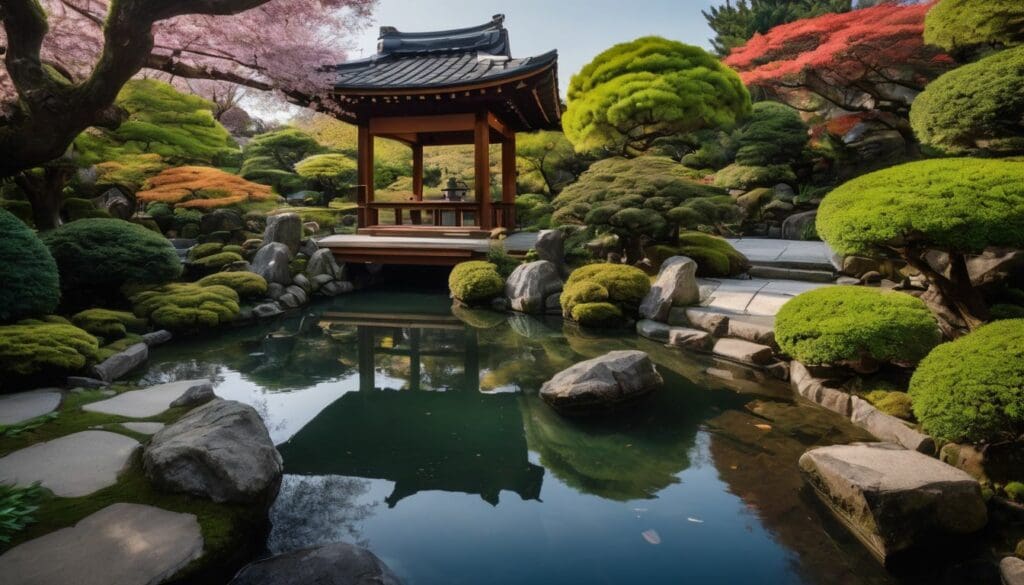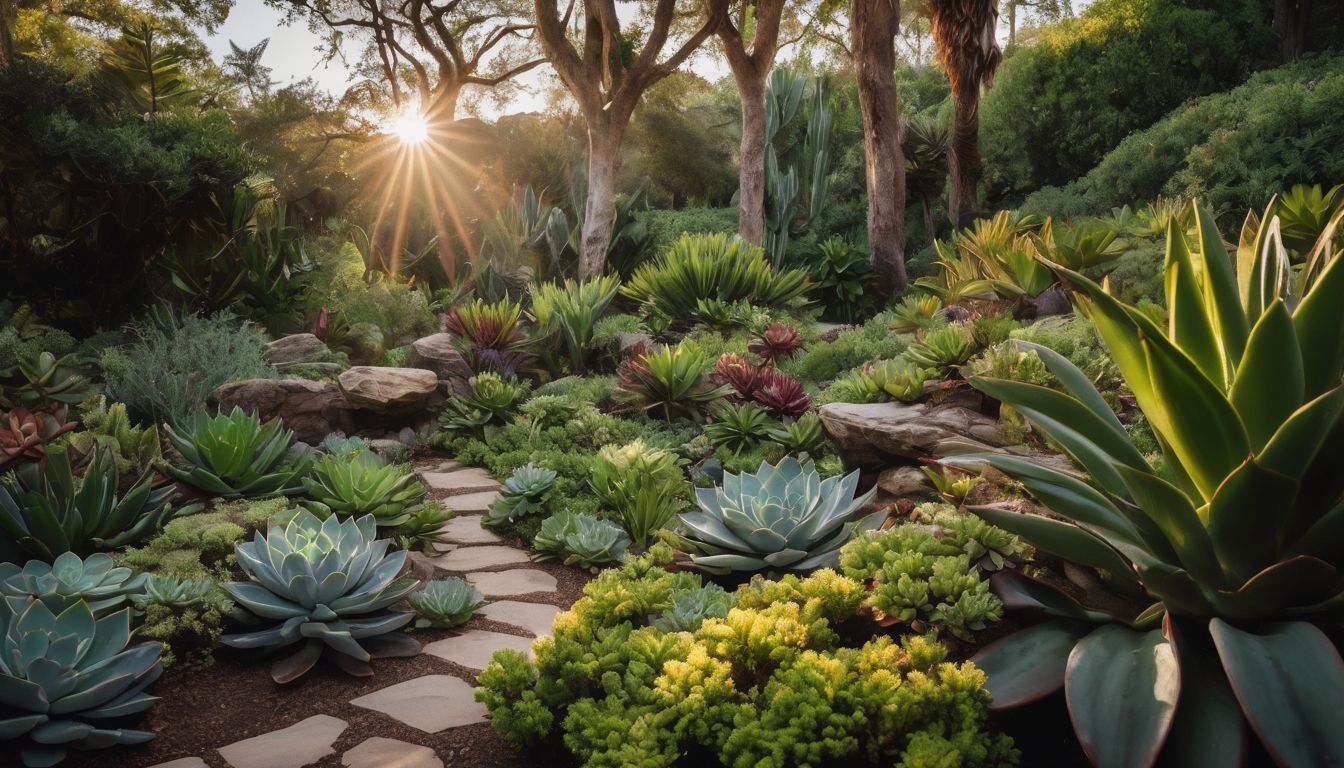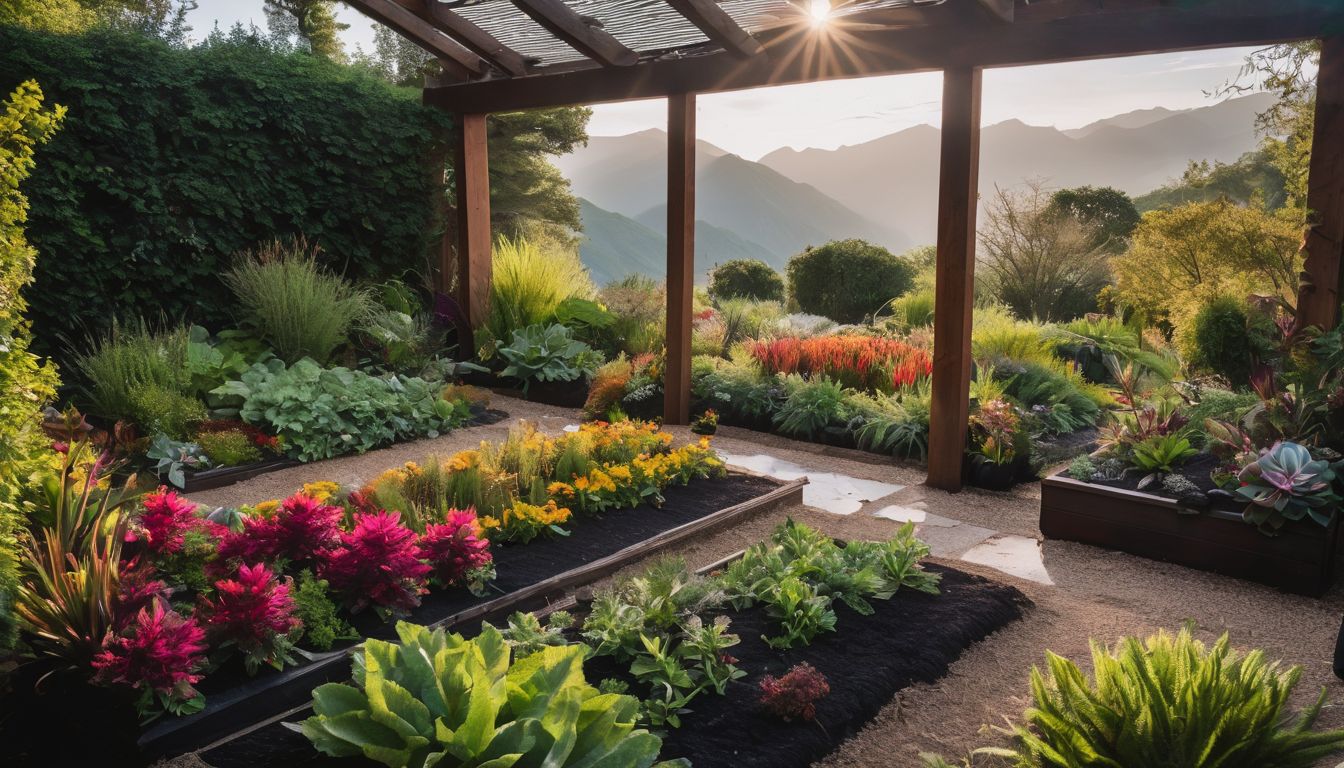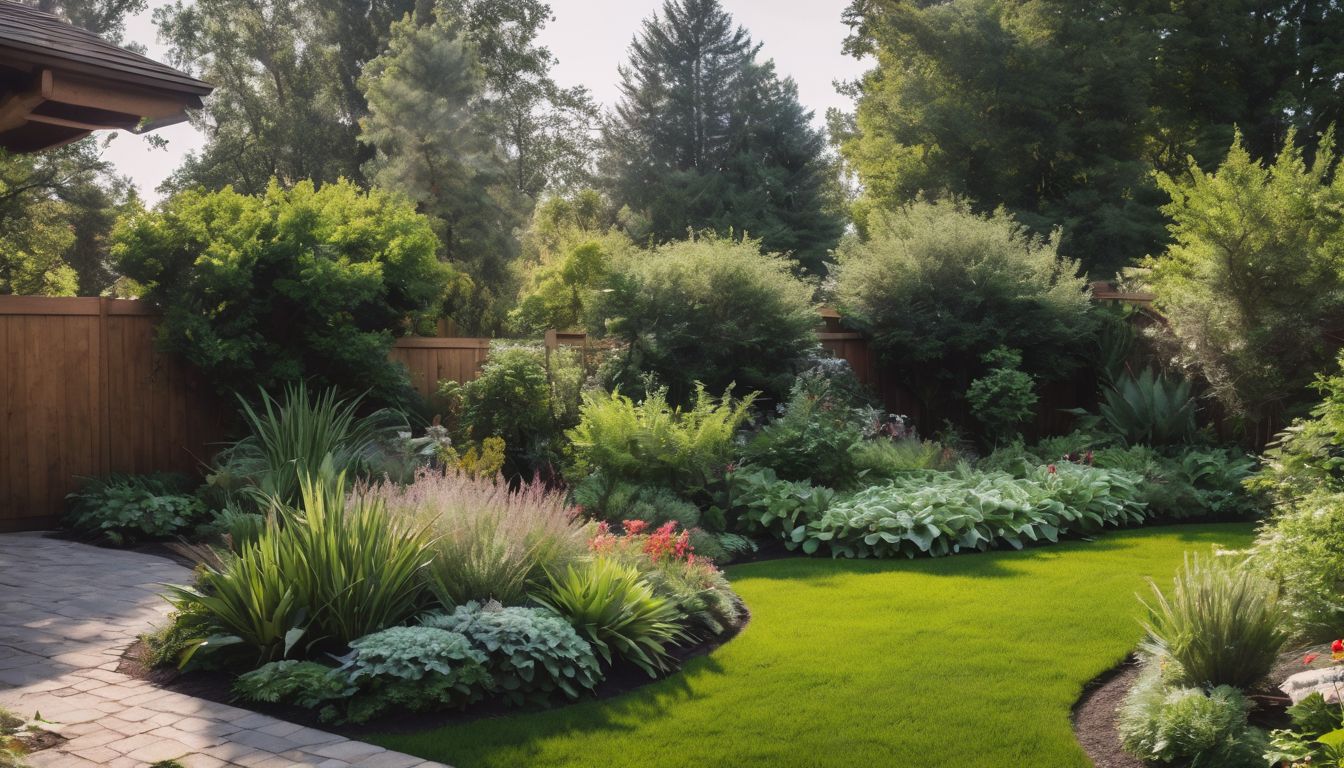Are you looking to bring tranquillity and beauty into your garden space? Japanese gardens have been captivating the world with their elegance for centuries. This article will guide you through the serene journey of crafting your own peaceful paradise using time-honoured Japanese garden design principles.
Discover serenity in simplicity—read on!
Key Takeaways
- Japanese gardens trace their roots to ancient Chinese and Korean influences, with development dating back to the 5th century in Japan.
- They feature a variety of types such as gravelled courtyards for meditation, aristocratic gardens displaying wealth, tea gardens for ceremonies, strolling gardens for leisurely walks, and Zen gardens for spiritual contemplation.
- Key design principles include asymmetry to reflect natural beauty, enclosure for tranquillity, borrowed scenery to blend with the environment, balance among different elements and symbolism that conveys deeper meanings through each component used.
- Essential elements in creating these tranquil landscapes include entrances that transition visitors into calmness, mystery through winding paths and hidden views, moss growth encouraged by shaded moist areas symbolising endurance and resilience.
- Common features found within Japanese gardens are water elements symbolising purity and renewal; integration of natural components like rocks and plants representing harmony with nature; a mix of man-made structures enhancing the atmosphere while maintaining respect for the environment.
The History of Japanese Gardens
Japanese gardens have a rich history, originally brought to Japan from China and Korea. The development of imperial gardens in the 5th century further shaped the unique style and design principles of Japanese gardens.
Imported from China and Korea
Garden design in Japan has its roots deeply entrenched in the ancient influences brought over from China and Korea. These cross-cultural exchanges introduced fundamental concepts that would evolve into what we now recognise as traditional Japanese gardens.
The adoption of Chinese gardening techniques began around the 6th century, merging with local aesthetics to form a distinct style.
Korean contributions were equally significant, infusing elements of their own garden culture into the mix. This confluence shaped a unique approach to landscaping and nature-inspired design, setting the stage for centuries of development in Japanese garden architecture and aesthetics.
Such early interactions paved the way for a rich tapestry of symbolism and philosophy in garden spaces that encourage meditation and harmonious living with nature.
Development of imperial gardens in the 5th century
In the 5th century, imperial gardens in Japan began to take shape, influenced by Chinese and Korean garden design. These early gardens reflected the power and aesthetics of the ruling class, with an emphasis on creating a serene environment for contemplation and relaxation.
Imperial gardens during this period showcased meticulous landscaping, ponds, bridges, and carefully placed stones to create a harmonious balance between nature and man-made elements.
The development of these early imperial gardens laid the foundation for the distinctive style and principles that would come to define Japanese garden design.
Imperial gardens originated in Japan during its formative years were integral in shaping Japanese garden culture as they set a precedent for integrating natural landscapes into constructed environments.
Types of Japanese Gardens
From gravelled courtyards to strolling gardens, Japanese gardens come in a variety of types and styles. Each type offers its own unique features and design elements that reflect the rich history and culture of Japan.
Gravelled courtyards
Gravelled courtyards, also known as “Karesansui,” are a type of Japanese garden that features raked gravel or sand to represent ripples in water. This design creates a serene and minimalist landscape, often found in Zen temples for meditation.
The careful placement of rocks and pebbles represents various natural elements like islands, rivers, and mountains whilst encouraging contemplation and stillness.
The simplicity of gravelled courtyards aligns with the principles of minimalism and natural inspiration prominent in traditional Japanese landscaping. This style offers an understated elegance that promotes tranquillity while reducing the environmental impact through its low maintenance requirements.
Aristocratic gardens
Aristocratic gardens, also known as daimyo gardens, were often created to showcase the wealth and status of feudal lords in Japan. These gardens typically featured expansive landscapes with carefully manicured lawns, ponds, bridges, and meticulously pruned trees.
They served as a symbol of prestige and power for the influential figures of the time.
Designed to impress and reflect the social standing of their owners, aristocratic gardens were often grand in scale and opulent in design. They incorporated elements such as large lanterns, decorative pavilions, and intricate stone arrangements to create an aura of luxury and refinement.
Tea gardens
Tea gardens, an essential part of Japanese garden design, offer a tranquil space for the traditional tea ceremony. With carefully arranged stepping stones leading to a small thatched-roof teahouse nestled amidst natural beauty, these gardens provide a serene setting for meditation and reflection.
Incorporating elements like bamboo fences, stone lanterns, and water basins contributes to the peaceful ambiance and complements the overall aesthetics of the space.
Tea gardens encourage a deep connection with nature and tranquility while exemplifying the principles of simplicity, harmony, and respect for the environment. Each element within these gardens has symbolic significance, contributing to an atmosphere that fosters mindfulness and appreciation for nature’s beauty.
Strolling gardens
Strolling gardens offer a serene and contemplative space for leisurely walks, often featuring meandering paths around a central pond or body of water. The design incorporates carefully placed rocks, plants, and bridges to inspire mindfulness and encourage peaceful reflection.
By introducing visitors to various scenic viewpoints throughout the garden, strolling gardens provide opportunities for appreciation of nature’s beauty in a tranquil setting.
Moving on from strolling gardens, let’s explore the Zen gardens with their minimalist aesthetic and meditative ambiance.
Zen gardens
Transitioning from the tranquil and introspective nature of strolling gardens, Zen gardens are a spiritual and meditative space. Sansui, or dry landscape gardens, prominently feature in Zen temple grounds.
These minimalist landscapes consist of carefully raked gravel to represent water and rocks symbolising islands or mountains.
The design is meticulously planned to foster contemplation and serenity. The spare arrangement promotes mindfulness while embodying simplicity and harmony with nature. The absence of plant life allows for year-round appreciation of its beauty; it’s an art form that encourages deep reflection on the impermanence of life.
Design Principles of Japanese Gardens
Japanese garden design principles focus on creating a sense of balance and harmony through asymmetry, enclosure, borrowed scenery, and symbolism. These principles are essential in creating a peaceful and aesthetically pleasing space.
Asymmetry
Japanese garden design embraces the principle of asymmetry, which creates a sense of natural beauty and harmony. This approach avoids rigid uniformity and encourages a more organic feel to the garden, reflecting the imperfections found in nature.
By introducing irregular shapes, varying textures, and different plant sizes throughout the landscape, asymmetry conveys a feeling of serenity and balance while also allowing for the dynamic interplay between light and shadow.
Implementing asymmetry in Japanese garden design enhances its overall aesthetic appeal by evoking a sense of free-flowing movement within the space. The deliberate lack of perfect symmetry adds an element of surprise for visitors as they explore each unique corner or path within the garden, providing an ever-changing experience that captures the essence of nature’s spontaneous beauty.
Enclosure
To complement the asymmetry in Japanese garden design, “Enclosure” offers a sense of tranquillity and privacy. Through the use of carefully positioned trees, shrubs, and architectural elements such as fences or walls, enclosure creates intimate spaces within the larger garden.
Taking inspiration from nature’s embrace, this principle encourages visitors to feel sheltered and secluded while immersing themselves in the beauty of their surroundings.
By incorporating enclosure into a garden, it fosters a sense of harmony between humans and nature. Enclosed spaces can evoke feelings of protection and peacefulness as one moves through different areas of the garden landscape.
Borrowed scenery
After creating a sense of enclosure within the garden, the next essential design principle is “borrowed scenery.” This concept involves incorporating surrounding natural elements into the garden landscape to enhance its beauty.
By strategically framing distant mountains, lakes, or other scenic views with carefully placed trees and meticulously selected plantings, Japanese gardens seamlessly integrate with their surroundings.
The borrowed scenery technique creates a harmonious connection between the garden and its environment while evoking a serene atmosphere that reflects reverence for nature.
In addition to borrowing scenic vistas as part of the garden’s design, this approach also integrates existing natural elements around the site. By thoughtfully incorporating nearby trees, authentic rock formations, or water features into the overall layout, Japanese gardens honour and celebrate nature’s intrinsic beauty.
Balance
Balance is a fundamental principle in Japanese garden design. It involves creating harmony and equilibrium between different elements, such as plants, rocks, water features, and built structures.
This balance can be achieved through careful placement of objects to create a sense of visual stability and tranquillity within the garden space.
Incorporating the concept of balance into a Japanese garden not only creates an aesthetically pleasing environment but also reflects the deeper philosophical values of respect for nature and finding peace within one’s surroundings.
Symbolism
Symbolism plays a vital role in Japanese garden design, with each element carefully chosen to convey deeper meanings. For example, the use of water symbolises purity and renewal while rocks represent strength and endurance.
Trees and plants are selected to evoke different emotions or reflect the changing seasons, creating an ever-evolving landscape that connects visitors with nature on a profound level.
Through carefully placed elements such as lanterns, bridges, and pathways, Japanese gardens communicate themes of transition, harmony, and mindfulness. These symbolic features encourage contemplation and evoke a sense of tranquillity within the space.
Essential Elements of Japanese Garden Design
Creating mystery and intrigue in the garden, encouraging natural moss growth, incorporating evergreen plants for year-round interest, building private pavilions for contemplation and relaxation.
Making an entrance
Guests are invited into the Japanese garden through carefully designed entrances, often marked by a wooden gate called “torii”. These entrances serve as transitions from the outside world to the serene and peaceful atmosphere of the garden.
Visitors are encouraged to slow down and appreciate the natural beauty, leaving behind the hustle and bustle of everyday life.
Stone pathways leading to the entrance may incorporate symbolic elements such as stepping stones or lanterns, enhancing the sense of anticipation and tranquility. As visitors pass through these entrances, they experience a deliberate shift in mindset – welcoming them into a space that encourages mindfulness and contemplation.
Creating mystery
Adding mystery to a Japanese garden involves using winding paths that lead visitors on a journey through the space, with hidden corners and unexpected views. By incorporating elements such as carefully placed rocks, tranquil ponds, and secluded seating areas, an air of intrigue is created within the garden.
The use of carefully pruned trees and shrubs can enhance this sense of enigma by providing partial glimpses of the surrounding landscape while maintaining an element of surprise.
Incorporating mystery within a Japanese garden encourages visitors to explore its depths and immerse themselves in its peaceful ambiance. This engenders a sense of wonder and discovery that aligns with the principles of harmony with nature and tranquility found in traditional Japanese culture.
Encouraging moss
Encouraging moss in Japanese garden design adds a touch of ancient beauty and tranquillity. By creating shaded areas with moist soil, the growth of moss can be fostered, complementing the overall peaceful atmosphere.
This natural carpet contributes to the serene aesthetic and symbolises endurance and resilience, harmonising perfectly with other elements such as stonework and evergreen plants. The presence of moss also aids in developing a sense of agelessness within the garden space, appealing to those appreciative of nature-inspired design.
Incorporating moss into Japanese garden landscapes enhances the allure of these serene spaces for environmentally conscious individuals who appreciate conservation efforts. Integrating this lush green element creates an enchanting ambiance full of symbolism linked to endurance and permanence that is sure to captivate admirers of nature-inspired design.
Incorporating evergreens
To complement the calming effect of moss, incorporating evergreens in Japanese garden design ensures year-round beauty and a sense of permanence. Evergreen trees and shrubs, such as pine, bamboo, and azaleas add structure, texture, and colour to the landscape.
These hardy plants thrive in various climates and require minimal maintenance once established. With their ability to retain foliage throughout the seasons, evergreens provide a natural backdrop for other elements within the garden.
Their presence further strengthens the connection to nature while contributing to the lasting allure of Japanese gardens.
The strategic placement of evergreens not only provides visual interest but also embodies longevity and resilience – essential characteristics that resonate with environmentally conscious individuals supporting conservation efforts.
Building private pavilions
Private pavilions are an essential feature of Japanese gardens, providing secluded spaces for contemplation and meditation. These traditional structures, often constructed from natural materials like wood and bamboo, offer a tranquil retreat within the garden.
Incorporating private pavilions into the landscape design encourages visitors to immerse themselves in nature while promoting a sense of harmony with the surroundings. The strategic placement of these pavilions allows for breathtaking views of the garden’s carefully curated elements, enhancing the overall experience.
Crafting private pavilions within a Japanese garden aligns with the principles of creating a peaceful and harmonious atmosphere. By integrating these serene spaces into the landscape, individuals can fully appreciate the beauty and serenity of nature while fostering an appreciation for environmentally conscious design practices.
Common Features of Japanese Gardens
Japanese gardens commonly feature water elements, such as ponds and streams, integrated with natural elements like rocks and plants. They also incorporate both natural and man-made objects to create a serene and harmonious atmosphere for visitors.
Use of water elements
Water elements play a crucial role in Japanese garden design, providing a sense of tranquillity and natural beauty. Ponds, streams, and waterfalls are utilised to create a serene atmosphere that reflects the harmony of nature.
The reflections on the water’s surface bring an added dimension to the garden, enhancing its aesthetic appeal and creating a peaceful ambiance for meditation or relaxation. Water also symbolises purity and renewal in Japanese culture, representing the flow of life and rejuvenation within the garden space.
Incorporating water into the design not only adds visual interest but also attracts wildlife such as birds and koi fish, promoting biodiversity within the garden ecosystem. Flowing through various levels with careful use of rocks and plantings enhances the overall sensory experience, engaging sight, sound, and touch for visitors.
Integration of natural elements
Natural elements play a crucial role in Japanese garden design, representing the harmony between humans and nature. Trees, plants, rocks, and water are carefully integrated to create a serene and peaceful atmosphere.
Each element is selected for its symbolic meaning, with evergreen trees symbolising longevity, while flowing water represents life and renewal. The deliberate arrangement of these natural features encourages visitors to contemplate the beauty of the environment and fosters a deep connection with nature.
Balancing natural elements within the garden not only enhances its aesthetic appeal but also promotes biodiversity and supports local ecosystems. By incorporating native plant species and utilising sustainable landscaping practices, Japanese gardens demonstrate an appreciation for the natural world while providing habitats for wildlife.
Incorporation of natural and man-made objects
Japanese gardens are known for seamlessly blending natural and man-made elements, creating a harmonious environment. Rocks, bridges, lanterns, and water basins are strategically placed to enhance the garden’s aesthetic appeal while maintaining balance with nature.
This integration reflects the reverence for the environment and showcases the art of finding beauty in simplicity without disturbing the natural landscape.
Carefully chosen plants complement these structures, adding seasonal variety and vibrant colors to the serene setting. The deliberate combination of both natural and artificial features such as stepping stones or perfectly pruned trees demonstrates a deep respect for nature’s inherent beauty while inviting contemplation.
Attention to detail and symbolism
Every element in a Japanese garden, from the carefully placed rocks to the choice of plant species, is purposefully selected and positioned to convey meaning and create a serene atmosphere.
Symbolism is paramount in Japanese garden design, with every stone, lantern, or tree serving as a deliberate representation of natural elements like mountains, waterfalls, or islands.
The meticulous attention to detail ensures that each feature in the garden has significance and contributes to the overall aesthetic harmony. By understanding these symbols and appreciating the intricate details woven into every aspect of a Japanese garden, one can truly immerse oneself in the tranquillity and spiritual depth they embody.
Creating a peaceful and harmonious atmosphere
Japanese gardens are designed to create a peaceful and harmonious atmosphere, blending natural elements with carefully placed man-made features. Through the use of water elements, such as ponds or streams, and the integration of natural materials like rocks and gravel, these gardens evoke a sense of tranquillity.
Incorporating evergreen plants provides a constant backdrop of lush greenery throughout the year, contributing to the serene ambiance. Attention to detail and symbolism in every aspect enriches the garden’s meaning and aesthetics.
The result is an environment that encourages mindfulness and inner peace, making it an ideal space for meditation or simply unwinding amidst nature-inspired design.
Moreover, Japanese garden design principles emphasise balance, asymmetry, enclosure, borrowed scenery; all working together to establish a sense of harmony within each unique landscape.
Conclusion
In conclusion, the art of Japanese garden design is a harmonious blend of nature and symbolism. Implementing essential elements such as creating mystery and incorporating evergreens ensures an aesthetically pleasing space.
The history, principles, and common features all contribute to the serene atmosphere of these gardens. Understanding these aspects allows for the creation of beautiful, sustainable outdoor spaces that reflect Japanese aesthetics and values.
FAQs
1. What are the key elements of a Japanese garden?
Key elements of a Japanese garden include water features, rocks, bridges, and carefully selected plants that follow nature-inspired design principles for tranquillity.
2. How does symbolism play a role in Japanese gardens?
Symbolism is central to Japanese gardens, with each element like water, stones, and plants representing different aspects such as purity, strength, and life’s constant change.
3. Can you explain Zen garden principles?
Zen garden principles focus on simplicity and minimalism to create peaceful meditation spaces using sand patterns and rock arrangements that encourage contemplation.
4. Why is bonsai important in Japanese gardening?
Bonsai embodies the art of patience and meticulous care in shaping miniature trees to echo larger landscapes found in nature within traditional Japanese gardening aesthetics.
5. What should I consider when planting a Japanese garden?
When planting a Japanese garden consider following specific techniques that balance seasonal colour changes while maintaining harmony between all natural components for an aesthetically pleasing composition.





